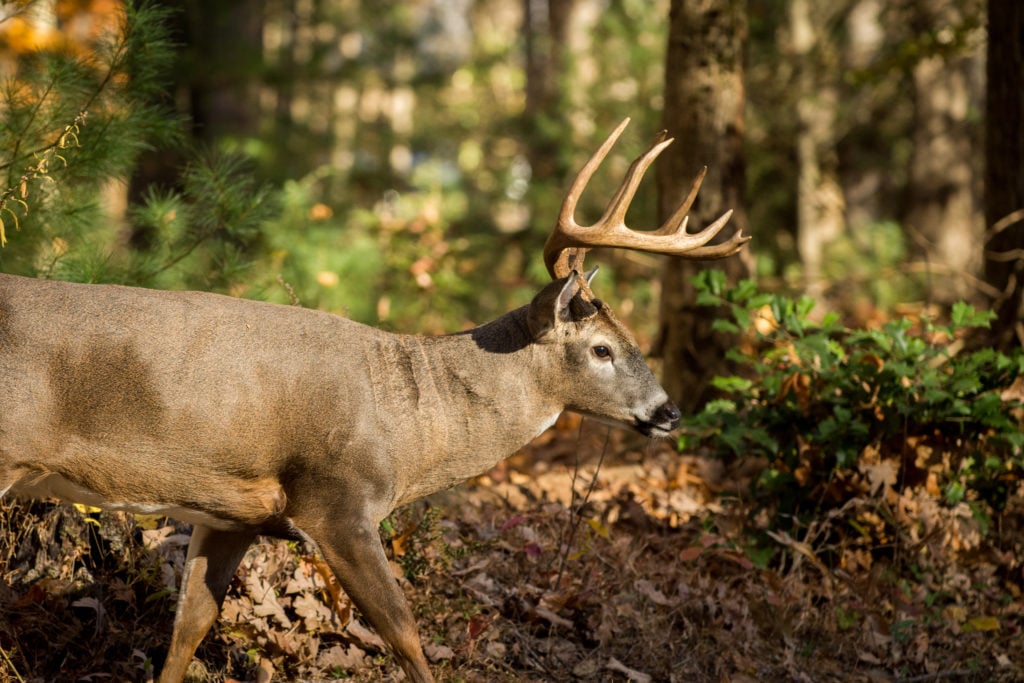
Timing the “drip rut” of the Southern whitetail breeding season differs from the Midwest and Northern predictions, but these suggestions can help you decide when to be in the stand.
Patterning a mature white-tailed buck is ultimately the key to a successful hunt. That, and a little bit of luck, of course. For many deer hunters, patterning a mature buck is dramatically easier the earlier or later in the season they hunt, when bucks tend to be on a bed-to-food schedule. As they hunt closer to the middle of the season, the rut throws them the proverbial curve ball. That’s not saying you can’t pattern a rutting buck, but it is increasingly more difficult with the unpredictability of chasing and breeding activity. However, this lasts for a couple of weeks for most, and then the bed-to-food schedule resumes.
But for Southern whitetail hunters the rut often teeters toward the end of the season. In all actuality, some of the best hunting in places such as Alabama, Mississippi and Louisiana can take place during the last day of the season in January or February! After an entire season of hunting pressure, trying to pattern a buck at this time can be tough. But add in the complexities of the Southern rut, and you have to wonder: Is it even possible to pattern a buck during this time of year?
Spend any time around Southern deer hunters and you’ll likely hear breeding activity described as a “drip rut” — quick flashes of rutting activity that disappear as quickly as they show up. That doesn’t necessarily mean a weak rut, but just not typical of what you see in Northern and Midwestern states, where the rut will be an intense two-week period at most. In the case of the Southern rut, it’s all about timing.
So how do you pattern rutting activity to enhance your chances of closing the deal on a Southern buck?
LISTEN TO WHAT THE
DEER ARE TELLING YOU
I strongly believe the ability to read deer sign is a fleeting skill in today’s hunting community. Long gone are the days when most deer hunters could walk into a new section of woods and put together a plan that would effectively end in a successful hunt. That’s not saying today’s deer hunters are bad hunters. In fact, success rates in many states are better than they have ever been and bigger bucks are being routinely killed. But there are a lot of factors that go into the success data, including state regulations designed to get bucks into older age classes, increased food plot popularity and the use of scouting cameras. If you want to nail down a mature buck during the Southern rut, you need to understand what local deer sign is telling you.
As bucks in the South teeter on the edge of the chase phase of the rut, they begin to move away from what many hunters have been targeting — scrapes. During the pre-rut, hunting scrape lines can be effective because multiple bucks are likely frequenting them. But as research from the University of Georgia indicates, most of the activity on these scrapes occurs after legal hunting hours have expired. So why pay attention to them?
First off, with the use of trail cameras, scrapes are likely to show you whether a shooter buck exists in the area to begin with. You can’t kill him, if he’s not there. But let’s assume that’s a given. Scrapes provide clues regarding the progression of rutting activity. As an active scrape turns “cold,” the odds are good that mature bucks are on the move cruising for estrous does. From this point forward, the scrapes will likely be more intermittently hit. This is a good time to locate pinch points and funnels and sit there all day.

FIND FAWNS FIRST
It might sound crazy, but determining if fawns are by themselves at this time of the year can help pinpoint Southern rut activity. As does approach estrus they send their button bucks packing, and with increasing pressure from bucks, doe fawns often end up on their own, too. A buck will work to isolate the doe he is tending away from other deer. Think about the rut and how many times you saw a couple of fawns on their own. Did the doe get shot? Was she hit by a car? The more likely cause of the fawns’ new independence is that a buck has pushed them away from the doe because she’s approaching, or is in, estrus.
Trail cameras on food sources are some of the most likely places to capture images of these fawns. The bottom line is that you better make a move quick, because the doe will likely be in estrus for only 24 hours or so. With the advent of cellular trail cameras, receiving and translating deer data in real time has changed the way many hunters hunt — including myself.

BALANCE THE HERD
This might not be an option for all Southern deer hunters, because many have only public land access, but most states and private landowners strive to create not just ample hunting opportunities but a healthy deer herd as well. Some research suggests the drip rut is not a Southern occurrence as much as it is an issue with the herd.
Most deer herds across the South have a skewed buck-to-doe ratio, in favor of does. There is only so much a buck can do to breed as many does as possible. Eventually more does come into estrus than available bucks are able to service and does are not bred. A doe will then cycle into estrus…





